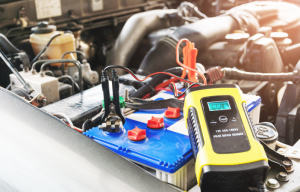In general, charging a car battery at 50 amps should take roughly an hour. However, it may take longer if your charger is incompatible with the battery or if the battery itself has a flaw. It might take up to 5 hours in some cases.
Improve your understanding of a battery Ampere Hour
Every automotive battery has what is known as a “Amp hour.” This is a rating that tells drivers how much amperage the battery can provide for one hour. This rating affects the voltage delivery, potential power, and runtime of the battery.
So, a battery with 1 Ah can keep a current of 1 amp going for exactly 1 hour. It could also deliver 2 amps of electricity for 30 minutes.
Calculating the Charge Duration
The duration of a charge is determined by a simple formula. You just multiply the reserve capacity of your battery by 0.6. Because reserve capacity is measured in minutes, you should have a decent idea of how long your automobile needs to be at full capacity again.
There are several amp chargers available. Each one charges automobile batteries at a different rate. The higher the number on your amp charger, the faster your battery charges.
Assume your battery has a reserve capacity of 100 minutes for the following instances. In each instance, multiply 100 by 0.6 to get 60 amps hours.
Using two amps
If your battery has 60 amp hours, a 2 amp charger will take 30 hours to completely charge it. Simply divide the number of amps by the number of amp hours to get this.
Using four amps
Using a 4-watt charger, it would take 15 hours to fully charge a battery with 60 watt-hours.
Using ten amps
A 10 amp charger would fully charge a battery in 6 hours.
Using 12 volts
A 12 amp charger can charge an automobile battery completely in 5 hours.
Using 50 watts
A 50 amp charger can quickly get your automobile back on the road. It would just take 1.2 hours to completely charge your battery again.
Charging at 50 amps is quick, but be careful!
A 50 amp charger sounds fantastic. However, you should use caution. At such a rate, the battery is at risk of overheating.
A higher amp rating indicates faster charging. If you leave the charger attached after the battery has been fully charged, problems are more likely to occur. Whatever charger you choose, make sure you remove it as soon as the battery is fully charged.
You may prevent this risk by using a slower charger. A 10 or 12-amp charger completes the task securely and in a fair length of time.
If the battery cannot be charged, it is time to replace it.
When you try to charge your automobile battery, something unexpected may happen. You may notice that the battery no longer holds a charge. You’re better off replacing the old battery with a new one at this point.
To replace a car battery safely, follow these instructions.
- Remove the negative cable from the negative termination while wearing gloves. This is denoted by a negative (-) symbol.
- Remove the positive cable from the positive terminal. This is denoted by a plus (+) symbol.
- Unscrew the connections and bolts that keep the battery in place.
- Remove the battery. Some automotive batteries can weigh up to 50 pounds, so proceed with caution.
- If you have all of the necessary safety gear, this should only take around 15 minutes. If you don’t feel comfortable doing it yourself, you can take your automobile to a mechanic. The cost of removing and replacing a car battery typically varies between $110 and $220.

How can I know if it’s my battery or anything else is wrong with my car?
If anything else is producing problems in your car, there is no need to replace the battery. This is why it is vital to have your automobile inspected by a professional at least once a year.